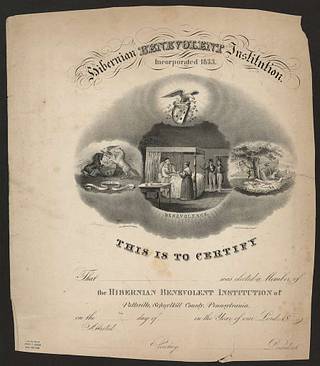
Hibernian Benevolent Institution, incorporated 1833 / design and on stone by J. Queen ; P.S. Duval Lith. Philada.
Summary
Print shows at center, beneath an eagle perched on an Irish harp, is a woman attending to a sick man as two well-dressed men enter the room; on the left are two horses and a shield above the motto "Virtue Liberty and Independence" and on the right is a tree and at the base are masonic implements and an Irish harp. Below the image is the text: "This is to certify that [blank] was elected a member of the Hibernian Benevolent Institution of Pottsville, Schuylkill County, Pennsylvania, on the [blank] day of [blank] in the year of our Lord 18[blank]. Attested [blank] Secretary. [blank] President."
Stamped in lower left: From the file of James F. Queen artist, 1824-1889.
Purchase; Marian Carson; 1997; (DLC/PP-1997:105).
Forms part of: Marian S. Carson collection at the Library of Congress.
Freemasonry's impact on America is more significant than anything that speculation would hold. A movement that emerged from the Reformation, Freemasonry was the widespread and well-connected organization. It may seem strange for liberal principles to coexist with a secretive society but masonry embraced religious toleration and liberty principles, helping to spread them through the American colonies. In a young America, Masonic ideals flourished. In Boston in 1775, Freemasonic officials who were part of a British garrison granted local freemen of color the right to affiliate as Masons. The African Lodge No. 1. was named after the order's founder, Prince Hall, a freed slave. It represented the first black-led abolitionist movement in American history. One of the greatest symbols of Freemasonry, the eye-and-pyramid of the Great Seal of the United States, is still on the back of the dollar bill. The Great Seal's design was created under the direction of Benjamin Franklin (another Freemason), Thomas Jefferson, and John Adams. Freemasonry principles strengthened America's founding commitment to the individual's pursuit of meaning. Beyond fascination with symbolism and secrecy, this ideal represents Freemasonry's highest contribution to U.S. life. Freemasons rejected a European past in which one overarching authority regulated the exchange of ideas. Washington, a freemason, in a letter to the congregation of a Rhode Island synagogue wrote: "It is now no more that toleration is spoken of as if it was the indulgence of one class of people that another enjoyed the exercise of their inherent natural rights. For happily, the government of the United States, which gives to bigotry no sanction, to persecution no assistance, requires only that they who live under its protection should demean themselves as good citizens..." Freemasonry's most radical idea was the coexistence of different faiths within a single nation.
The Americana collection of Marian Sadtler Carson (1905-2004) spans the years 1656-1995 with the bulk of the material dating from 1700 to 1876. The collection includes more than 10,000 historical letters and manuscripts, broadsides, photographs, prints and drawings, books and pamphlets, maps, and printed ephemera from the colonial era through the 1876 centennial of the United States. It is believed to be the most extensive existing private collection of early Americana. The collection includes such important and diverse historical treasures as unpublished papers of Revolutionary War figures and the Continental Congress; letters of several American presidents, including Thomas Jefferson; a manuscript account of the departure of the first Pony Express rider from St. Joseph, Mo.; and what may be the earliest photograph of a human face. Many of the rare books and pamphlets in the collection pertain to the early Congresses of the United States, augmenting the Library's unparalleled collection of political pamphlets and imprints. The Carson Collection adds to the Library's holdings the first presidential campaign biography, John Beckley's Address to the people of the United States with an Epitome and vindication of the Public Life and Character of Thomas Jefferson, published in Philadelphia in 1800. The book was written to counter numerous attacks against Jefferson's character, which appeared in newspapers and pamphlets during the bitter election campaign. The Rare Book and Special Collections Division shares custodial responsibility for the collection with the Library's Geography and Map Division, Music Division, Prints and Photographs Division, and the Manuscript Division.
Tags
Date
Contributors
Location
Source
Copyright info






![Lincoln and Hamlin / designed by J.N. Hyde ; drawn on stone by D[ominique] C. Fabronious. Lincoln and Hamlin / designed by J.N. Hyde ; drawn on stone by D[ominique] C. Fabronious.](https://cache.getarchive.net/Prod/thumb/cdn4/L3Bob3RvLzIwMTkvMDkvMTgvbGluY29sbi1hbmQtaGFtbGluLWRlc2lnbmVkLWJ5LWpuLWh5ZGUtZHJhd24tb24tc3RvbmUtYnktZG9taW5pcXVlLWMtZmFicm9uaW91cy03ZjJmMmItNjQwLmpwZw%3D%3D/40/50/jpg)










































